As a product manager or product developer, you know that building a great product isn’t just about features—it’s about creating something that truly resonates with users. But how do you ensure your product aligns with customer needs, expectations, and pain points? The answer lies in asking the right product survey questions to the right people at the right time.
Product surveys are a goldmine of insights that can shape your product development strategy. Whether you're measuring customer satisfaction, evaluating NPS scores, or identifying opportunities for improvement, well-crafted product survey questions can help you unlock meaningful, actionable data. But not all surveys deliver valuable insights—it’s the quality of the questions you ask that makes the difference.
In this blog, we’ll dive deep into product satisfaction survey questions, sharing examples tailored for different use cases. Whether you're launching a new product, improving an existing one, or optimizing user experience, these survey questions will help you gather the right feedback to refine your product, drive growth, and enhance customer loyalty.
Let’s get started!
TL;DR
-
Product surveys are conducted by companies to gather valuable feedback from customers to understand their preferences and improve products or services based on customer personas and needs.
-
It helps in aligning product roadmap development efforts with user needs and incorporating new ideas based on customer insights to increase product satisfaction.
-
Product survey question examples can include questions on various stages of the product including idea generation, development stage, post-release optimization, new feature addition, and more.
-
Based on various touchpoints in the user's journey, product feedback survey questions can be about onboarding, post-purchase, post-usage, upgrades or renewals, abandonment, and cancelations.
-
Product feedback surveys can also gauge CX metrics like NPS, CSAT, and CES, providing you with insights into overall customer satisfaction, loyalty, and the effectiveness of their customer support and service experiences.
-
Leveraging multiple survey channels like email, website, in-app, and in-product and adding product survey types like popup surveys, popover surveys, and feedback buttons to them can help in collecting product feedback that is comprehensive and diverse.
-
Zonka Feedback is a versatile online survey tool that you can use to create product feedback surveys and send them to the right audience via different survey channels. You can schedule a demo to understand how you use it for your product feedback survey.
Measure Product Feedback & User Insights 💻
With Product Feedback Surveys, understand what users need and learn ways to delight your customers.

What is a Product Survey?
A product survey is conducted by different sizes and types of businesses to understand what users think about their products. It involves creating and deploying well-crafted product survey questions to collect information that shapes the product roadmap based on user feedback.
A product survey can be conducted to capture feedback on various aspects of the product, such as usability, user interface, features, general suggestions, and so on.
If you want to conduct a product survey and see how your potential customers and active users like your product, you can leverage this product survey template and share it with your users through in-app/product, embed it on the website, or simply share via email.
Why You Should Run Product Surveys
Product survey offer a unique opportunity to listen attentively to your users, enabling you to shape your product strategy based on customer expectations. Let us look at the reasons why every company that is driven by product-led growth should conduct product surveys.
1. Gain Data-Driven Insights About Your Target Users
Guesswork has no place in product development. A well-structured product survey helps you collect real user feedback—whether it's about their experience with your product, your brand perception, or pain points they face.
With this data, you can:
-
Build more accurate customer personas
-
Improve your customer support by addressing common friction points
-
Refine your sales and marketing strategies based on real user needs
Simply put, product survey questions turn assumptions into informed decisions, helping you build a product that truly resonates with your audience. By collecting product feedback, opinions, and preferences, you can tailor your product to their specific requirements and ensure that it resonates with customers' expectations.
2. Involve Customers in Your Product Roadmap
Your customers are your best source of innovation. Their feedback can guide you in improving your product and aligning it with their expectations.
By running product surveys, you:
-
Get insights into what features or improvements matter most
-
Validate ideas before investing time and resources
-
Strengthen customer relationships by showing you value their input
Listening to your users isn’t just about improving your product—it’s about making them feel heard and involved. This ensures that your product development efforts align with customer needs, increasing the chances of delivering a solution that truly solves their problems and delights them. This, in turn, boosts loyalty and engagement.
3. Discover New Feature Ideas and Enhancements
Some of the best product innovations come from your most loyal users. Product surveys act as brainstorming sessions, allowing customers to share ideas that you may not have considered.
To encourage more creative feedback:
-
Use open-ended questions to let customers share their thoughts freely
-
Follow up on simple “yes or no” responses for deeper insights
-
Ask about their biggest pain points to uncover improvement opportunities
Measuring customer satisfaction allows you to uncover innovative suggestions and identify potential opportunities that you may not have considered. This relevant customer feedback can fuel your creativity and guide you in developing new products or expanding existing offerings.
4. Simplify the Process of Collecting Insights
Understanding customer sentiment doesn’t have to be complex. With targeted product surveys, you can segment your audience and capture valuable feedback at different touchpoints. For instance:
-
Run surveys for new users to gather their initial impressions
-
Survey your most engaged customers to understand what keeps them loyal
-
Use exit-intent surveys to identify why users might be leaving
By strategically placing surveys throughout the user journey, you can capture insights that drive meaningful improvements.
5. Measure and Improve Customer Satisfaction
If you want to improve customer satisfaction, you need to measure it effectively. Product survey questions like NPS (Net Promoter Score) and CSAT (Customer Satisfaction Score) help you track satisfaction levels and pinpoint areas that need attention. For example:
-
NPS surveys help gauge customer loyalty and the likelihood of referrals
-
CSAT surveys measure overall customer satisfaction with your product or service
-
CES (Customer Effort Score) surveys reveal how easy it is for customers to use your product
By analyzing survey responses, you can proactively address customer concerns and enhance their experience.
Product surveys are more than just a way to collect feedback—they’re a powerful tool for growth. By running strategic surveys, you can make data-backed decisions, refine your product roadmap, and improve customer satisfaction.
New Product Survey Questions Examples
Launching a new product is exciting but understanding how your customers perceive it is crucial for success. A well-designed new product survey helps gather actionable feedback, refine features, and enhance customer satisfaction. Here are some product survey questions to ask when evaluating a new product.
1. First Impressions Matter
- What’s your first impression of our new product?
- What made you interested in trying our product?
2. Purchase Intent & Interest
- How likely are you to purchase this product?
- What features appeal to you the most?
3. Product Fit & Market Comparison
- How well does this product address your needs?
- Would you choose this product over competitors?
- What sets our product apart from similar options in the market?
4. Usability & Experience
- How easy is it to use this product?
- Is there anything about the product experience that needs improvement?
5. Missing Features & Enhancements
- Are there any key features missing that you expected?
- What improvements would make this product more valuable to you?
6. Overall Satisfaction & Value Perception
- How satisfied are you with this product?
- How would you rate the product’s value for its price?
- On a scale of 1 to 10, how likely are you to recommend this product?
Conducting market research with the right product survey questions to ask ensures that your product meets customer expectations. Their feedback allows you to make data-driven improvements, refine your offering, and enhance customer satisfaction for long-term success.
Product Survey Question Examples to Create Exceptional Product
If you want to create an unbeatable product, your survey questions should be specific to your survey goals. Let us look at the product survey questions to ask about different aspects to gather meaningful insights and drive improvements in your product.
1. Idea Generation
If you want to broaden your product possibilities and unlock innovative solutions, you must engage users through product feedback survey questions. By turning users into co-creators, you cultivate ownership, customer loyalty, and alignment with their needs, ensuring that developed features resonate closely with expectations.
-
What features or improvements would you like to see in our product that is currently missing?
-
Is there anything you wish our product could do that it currently doesn't?
-
Are there any emerging trends or technologies that you believe our product should incorporate?
-
Are there any existing products or services in the market that you find inspiring or particularly well-designed?
-
Would you be interested in participating in future user research or beta testing opportunities to help shape the direction of our product?
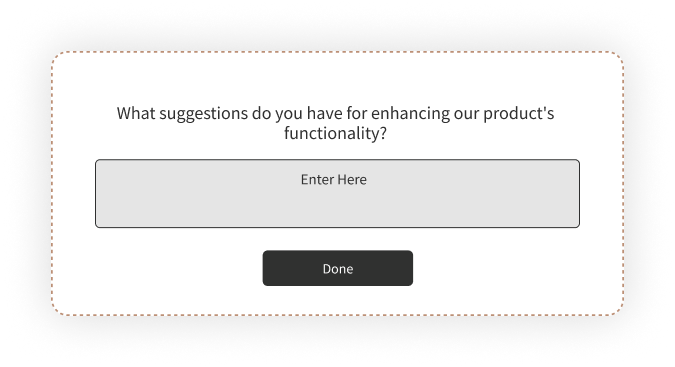
2. Development Stage
Product managers especially need to clearly understand what users want and need from their products. By asking the right product research survey questions in the development stage, you can gain insights into what features or functionalities your users are looking for, how they perceive the current state of your product, and what improvements or additions they would like to see.
This feedback can not only help you identify areas that need improvement but also provide product idea validation and reassurance that you are on the right track.
-
What features or functionalities would you like to see in the product?
-
How user-friendly is the product's user interface?
-
Are there any technical issues or bugs that you have encountered while using the product?
-
Are there any specific pain points or areas for improvement that you have identified?
-
How satisfied are you with the product's current features and functionalities?
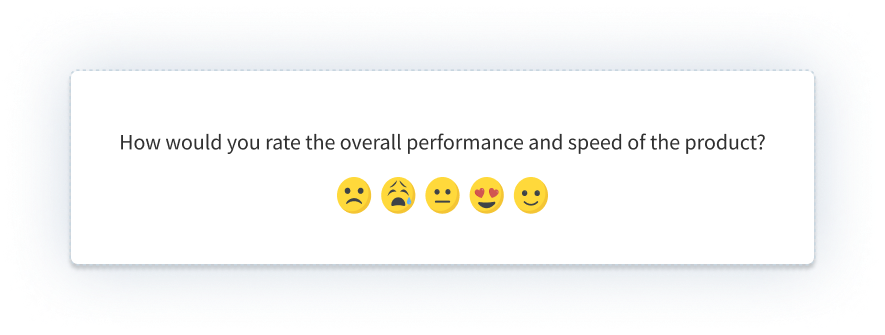
3. Post Release Optimization
Conducting product survey questions post-release is important as it allows you to understand customer concerns and collect insights after the product has been launched. By conducting this survey through your product feedback software, you can gain a deeper understanding of how your product is performing in the market and how your target audience is receiving it.
-
How satisfied are you with the overall performance of our product?
-
Are there any specific features or functionalities that you find particularly useful or enjoyable?
-
Have you encountered any bugs or technical issues while using our product?
-
Is there anything you would like to see improved or added to our product?
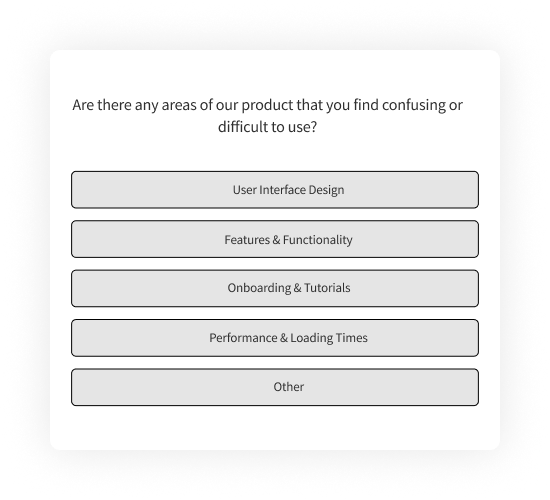
4. New Product Feature
As a product manager, you would want to ensure that any feature you introduce adds value to your product and enhances the consumer experience. By including questions about new features in your product survey and by running a beta testing survey, you can gather feedback on their usability, usefulness, and overall user satisfaction.
By measuring product feature feedback, you can make informed decisions about the future of your product and prioritize product feature requests from users that will have the maximum impact.
-
Are there any challenges or difficulties you encountered while using the updated feature?
-
How frequently do you use the new feature?
-
Is there anything missing or lacking in the new feature that you expected?
-
Would you like to see any additional enhancements or modifications to the new feature in the future?
-
Were there any unexpected positive or negative outcomes from using the new feature?
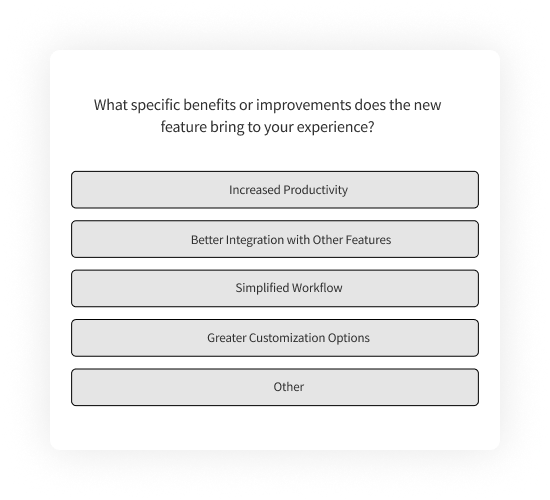
5. Gauging Product Experience
Asking questions about the overall product experience is crucial for understanding how users interact with and perceive your product. It provides a holistic view of user satisfaction levels, identifies areas of delight or frustration, and sheds light on aspects that are most valuable to users. This feedback enables you to make data-driven decisions to enhance the product and improve overall customer engagement.
-
What aspects of our product do you find most valuable or enjoyable?
-
Are there any specific features or functionalities that you particularly appreciate in our product?
-
Did you encounter any challenges or difficulties while using our product?
-
Have you experienced any technical issues or bugs while using our product?
-
What improvements or enhancements would you like to see in our product to better meet your needs?
-
How well does our product meet your expectations in terms of its capabilities and performance?
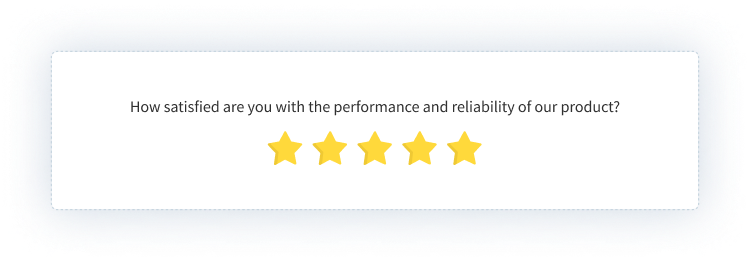
6. Mapping Product Churn
Product churn survey questions can help you uncover common customer churn reasons such as usability problems, lack of desired features, poor customer support, etc. Armed with this information, you can make strategic decisions to address these issues and enhance customer relations, ultimately reducing churn, increasing customer retention, and acquiring new customers.
You can use a ready-to-use product churn survey template to quickly create this survey and measure the feedback to assess all pain points.
-
Were there specific features or functionalities that you found lacking or unsatisfactory?
-
Did you encounter any difficulties or obstacles that prevented you from fully utilizing our product?
-
Is there anything we could have done differently to retain you as a customer?
-
Were there any issues or problems that were unresolved during your usage of our product?
-
Did you find our product difficult to integrate or use within your existing workflow? If yes, please elaborate.
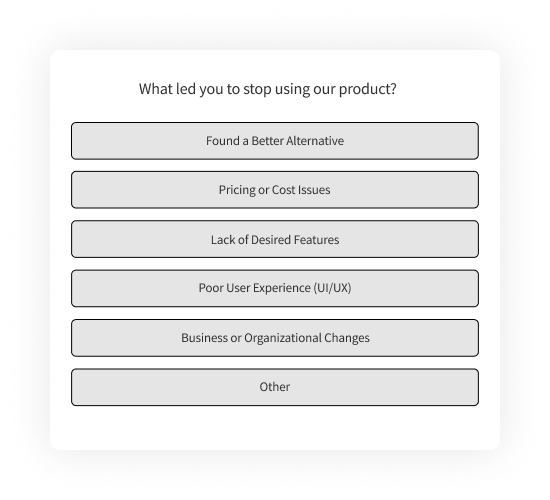
7. Competitor Analysis
In a competitive market, survey users on competitor awareness, satisfaction, and appealing features. You can differentiate your product with these insights and refine product marketing and positioning strategies to effectively communicate your unique value proposition.
-
What do you perceive as the main strengths of our competitors' products or services?
-
Are there any features or functionalities offered by our competitors that you find appealing or superior?
-
How is our product compared to competitors in terms of quality, performance, and user experience?
-
What factors influenced your decision to choose our product over competitors?
-
Are there any gaps or areas where our product falls short compared to our competitors?
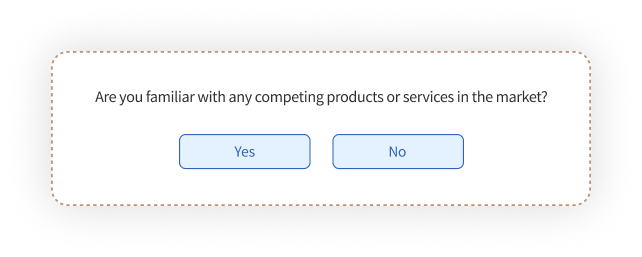
8. Product Performance
There might be some areas where the performance of your product might not be meeting user expectations. Product performance-based questions can help you identify any issues or bottlenecks that users may be experiencing, allowing you to address them promptly and ensure healthy customer relations.
-
Have you experienced any technical issues or crashes while using our product?
-
How would you rate the accuracy and reliability of the data or results provided by our product?
-
Does our product meet your expectations in terms of its stability and consistency?
-
Have you encountered any delays or latency when using our product?
-
How satisfied are you with the loading times and response times of our product?
-
Are there any particular features or functionalities that you find slow or inefficient?
-
Does our product integrate seamlessly with other tools or systems you use?
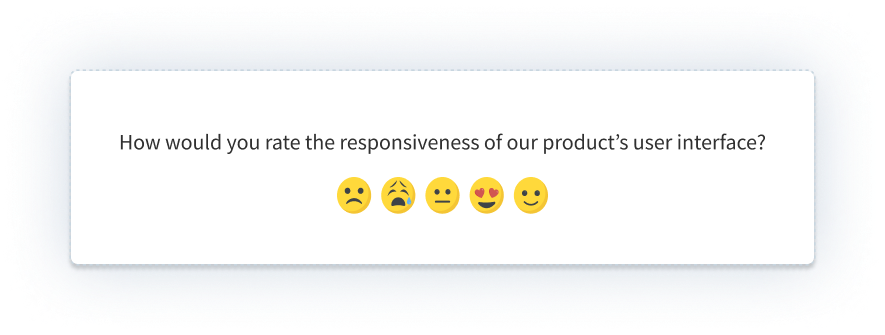
9. Missing Features
According to research, the probability of selling your product to existing users is 60-70%, while to a new user is 5-20%. Therefore, by incorporating missing features based on in-app user feedback, you can attract new users and retain existing ones. You can ask users about missing features to understand their specific needs and uncover gaps in your product offering.
-
Are there any particular features or functionalities that you wish our product had but are currently missing?
-
Are there any tasks or workflows that you find difficult to accomplish with our current feature set?
-
Are there any industry-specific features or requirements that you feel our product should address?
-
Are there any integrations with other tools or systems that you would like to see in our product?
-
Are there any improvements or additions you would suggest to enhance the overall user experience and usability of our product?
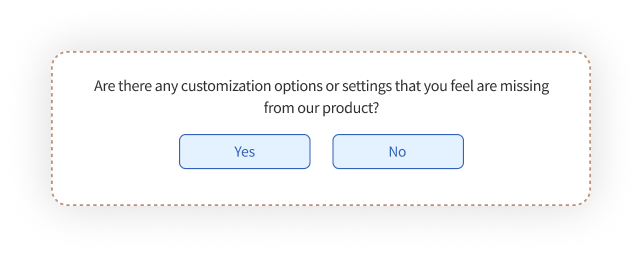
Product Survey Questions Examples Based on Various Touchpoints in User's Journey
To gain a comprehensive understanding of user experience and drive success, it is crucial to conduct a product survey across all touchpoints. By implementing online surveys and collecting user touchpoint insights, you can identify areas for improvement, detect issues, and uncover delightful moments throughout the user journey.
Let's explore the key touchpoints where product survey questions can be of utmost importance.
1. Onboarding
Onboarding sets the tone for a user's journey, and if it's too complex, studies show that 74% may switch to other solutions. Including product onboarding survey questions during onboarding is crucial to gauge the initial impression and experience. A great survey software or best survey apps will come with a ready-to-use customer onboarding survey template that you can quickly use to ask your product survey questions around onboarding.
-
Did you find the onboarding instructions and guidance provided helpful in getting started with our product?
-
Were there any aspects of the onboarding process that you found confusing or difficult to understand?
-
Did you face any challenges while completing the setup steps during onboarding?
-
Did you feel that the onboarding process effectively communicated the value and benefits of our product?
-
What suggestions do you have for improving the onboarding experience and making it more seamless for new users?
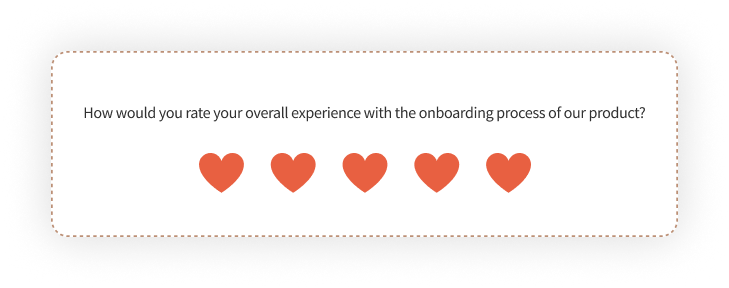
2. Post Purchase
Post-purchase survey questions capture feedback on the product, buying process, and customer support. This approach unveils insights into potential issues during the purchase journey, demonstrating a commitment to user satisfaction and improving NPS scores. You can easily build your post-purchase product survey by using a customer feedback tool that offers a post-purchase survey template within a few minutes.
-
How would you rate the value for money of our product?
-
Have you experienced any issues or concerns with our product since your purchase?
-
How responsive and helpful do you find our customer support team in addressing your post-purchase queries or issues?
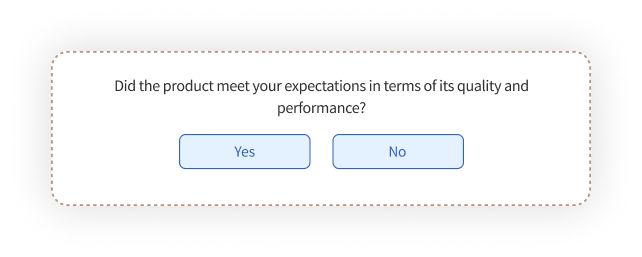
3. Post Usage
Understanding what value your users drive from your product is vital for your product's success. Including product survey questions after users have used your product enables you to understand the product's effectiveness and potentially identify opportunities for upselling or cross-selling.
-
How satisfied are you with your overall experience using our product?
-
What particular features do you find most valuable in our product?
-
Have you encountered any challenges or difficulties while using our product?
-
How would you rate the user-friendliness and ease of use of our product?
-
Are there any improvements or enhancements you would suggest to make our product even better?

4. Upgrades or Renewals
During upgrades or renewals, surveying users provides insights into customer satisfaction, loyalty, and motivations. By asking product feedback questions to identify what aspects of your product users appreciate and value, you can gain valuable insights into what sets your product apart from competitors and highlights your USP.
-
How satisfied are you with the recent product update or renewal process?
-
Were you adequately informed about the new features or improvements introduced in the latest update?
-
Have you encountered any challenges or difficulties during the product update or renewal process?
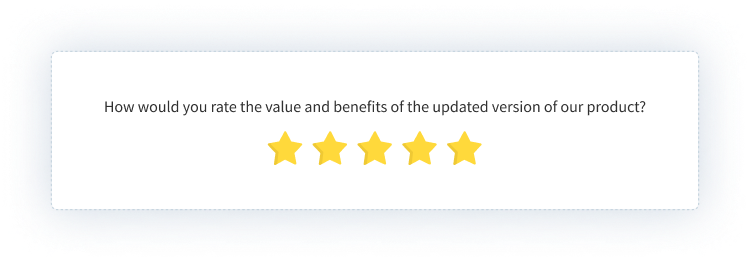
5. Abandoned Carts
Abandoned carts represent a missed opportunity, and understanding the reasons behind cart abandonment allows you to gather feedback on any barriers, concerns, or issues that led to the abandonment. This information helps you optimize the checkout process, identify friction points, and implement strategies to reduce cart abandonment rates.
-
Why did you recently abandon your purchase while attempting to make a purchase on our app/website?
-
Were there any concerns or doubts about the product or its suitability that led to the abandonment of your cart?
-
Did you encounter any difficulties or delays in accessing or using a discount code or promotional offer during the checkout process?
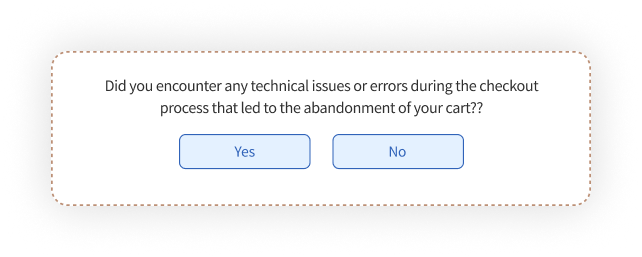
6. Exit or Cancellations
Collecting subscription cancellation feedback is essential to know the reasons why users decide to discontinue their relationship with your product. Including product survey questions during exits or cancellations allows you to take immediate action and offer some alternative to retain users from churning.
-
Did you encounter any challenges or difficulties while using our product that influenced your choice to cancel?
-
Did you find the product pricing or subscription plans suitable for your needs?
-
Were there any issues with our product's performance, reliability, or stability that contributed to your decision to exit or cancel?
-
Were there any factors outside of our product that influenced your decision to exit or cancel?
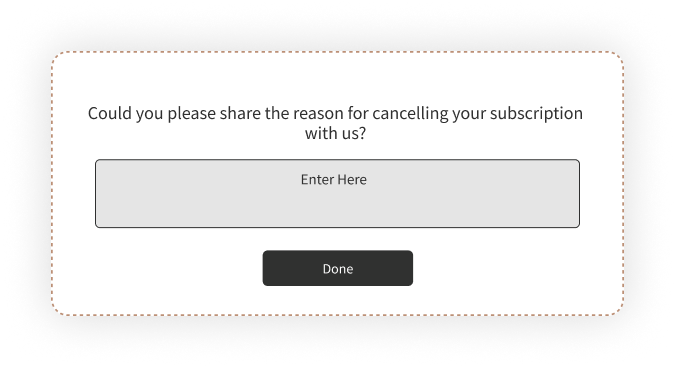
7. Periodic Check-ins
Periodic check-ins throughout the user's journey allow you to assess their ongoing experience and satisfaction with your product. Including product survey questions during these check-ins helps you to proactively address users' issues, adapt to their changing requirements, and continuously improve the user experience.
-
Are there any specific features or functionalities that you have started using or find particularly valuable?
-
Have you encountered any challenges or difficulties while using our product?
-
How well does our product align with your evolving goals or objectives?
-
Are there any areas where you feel our product could further improve to better meet your evolving needs?
Product Survey Questions to Ask Customers based on CX Metrics
Customer experience metrics provide specific and standardized measurements that help gauge customer sentiment and drive improvements not just in your product but overall performance. Through CX metrics like CSAT (Customer Satisfaction Score), NPS (Net Promoter Score), and CES (Customer Effort Score), you can prioritize improvements, increase satisfaction, and bring loyalty to your user base.
Let us look at the product survey questions to ask based on customer satisfaction metrics and experience you can include in your product survey.
a. Net Promoter Score (NPS)
Product Net Promoter Score survey is a metric that measures customer loyalty and the likelihood of customers recommending your product or service to others. By including NPS survey questions, you can assess loyal customers and identify promoters, passives, and detractors.
Here's how you can frame your product NPS survey question:
-
On a scale of 0 to 10, how likely are you to recommend our product/service to others?
To know the reason behind the NPS score given by the customers, you should ask a follow-up open-ended question.
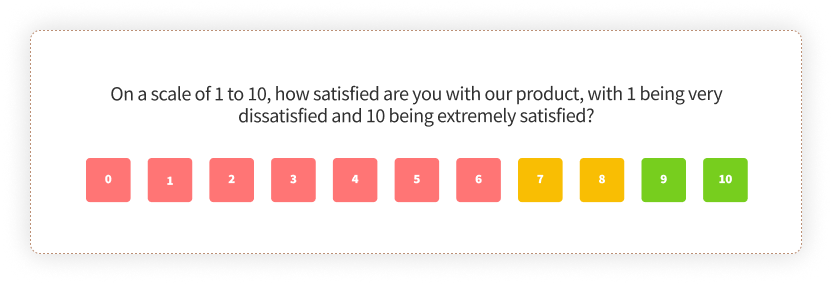
b. Customer Satisfaction (CSAT)
Product customer satisfaction survey questions (CSAT) help you to quantify customer satisfaction levels with your product and track changes over time. This metric provides actionable insights to drive customer-centric decision-making and prioritize initiatives that enhance satisfaction.
A very popular product customer satisfaction survey question would be:
- On a scale of 1 to 5, how satisfied are you with our product/service?

c. Customer Effort Score (CES)
Product CES survey questions can understand the level of effort users perceive in various interactions with your product. Customer Effort Score helps you identify areas where users may face difficulties or frustrations, allowing you to streamline processes, simplify workflows, and reduce friction.
An example of a product CES survey question would be:
- To what extent do you agree: The company made it easy for me to handle my issue.
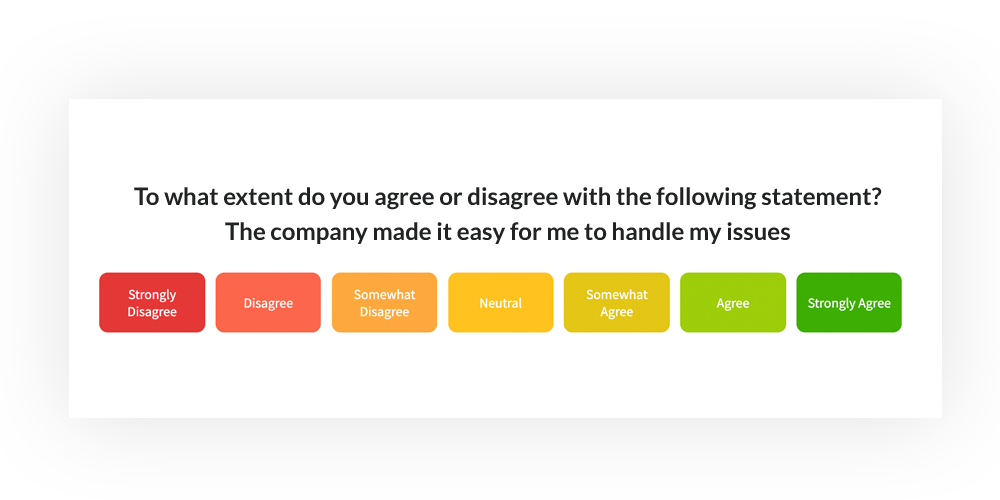
Sharing Product Survey for Gauging Customer Satisfaction
Once you have created your product survey, it is time to share it with your user base through a platform where they would notice it and take the survey. If you want to boost your product survey response rate past 85%, you have to execute your survey really well through a popular survey distribution channel.
Let us look at the most popular survey collection channels that can get you the maximum product survey responses.
1. In-app/product
Embed your survey directly within your app or product to engage users seamlessly. This ensures convenience and higher participation rates as users can access and complete it without leaving the app. Consider using unobtrusive in-app notifications or dedicated survey sections within your product.

2. Website
Embedding the survey directly on your website eliminates the need for users to navigate away. You can place the product survey prominently on relevant pages of your website, such as the homepage or product-specific pages, for maximum visibility.
Utilize eye-catching banners, popup surveys, or dedicated survey pages to encourage user participation.
3. Email
Leveraging an email survey allows you to directly reach users who are already in your contact list or customer database. Craft engaging emails that clearly convey the survey's purpose and importance, and include a call-to-action button or link.
You can personalize the email with user names, subject lines, etc. can boost open and response rates.
Types of Product Surveys to Collect Customer Feedback
There are many different types of product surveys that you can implement in your app or product or on the website. Let us look at some of the most popular ones that can get you maximum response.
-
Popover Survey: A non-intrusive, small window in the product's interface that can be strategically placed at relevant moments during the user's journey, such as after completing a task or when encountering a specific feature.
-
Popup Survey: Used to get immediate and noticeable feedback requests within the product. It's important that surveys comprising popup survey questions are well-timed and not overly intrusive to avoid disrupting the user experience.
-
Feedback Button: A feedback button is a persistent element within your product's user interface that can be displayed as a button or icon that users can click to open a feedback form or survey.
-
Slide-up Survey: Small panel sliding from the screen's edge to engage users without obstructing the main content.
-
Bottom Bar Survey: It appears as a persistent bar at the bottom of the screen and stays fixed as the user navigates through different pages or sections of the product.
-
Microsurvey: Used to collect feedback on specific touchpoints, features, or interactions within the product journey with quick one or, at max, two questions. Due to their brevity, microsurveys can be easily integrated into the user interface of the product, such as through a popover, slide-up panel, or feedback button.
Best Practices for Creating Product Surveys
To maximize the effectiveness of your product survey, consider key factors when creating it. Let us look at some best practices that can enhance your survey's impact.
1. Set your Goals
Before creating a product survey, clearly define your goals and the specific information you aim to collect. Whether you want to create a product survey to gather feedback on premium features or on general user satisfaction, setting clear goals can help you focus your product survey questions and ensure that the collected data aligns with your objectives.
2. Ask Relevant Questions based on Use Case
Craft a survey question that is relevant to your use case and the purpose of the survey. Tailor the questions to gather insights specific to your product, target audience, and industry. By asking questions that directly address the topics you want to explore, you'll obtain targeted and actionable feedback to guide your decision-making.
3. Avoid Leading Questions
When formulating product survey questions, it's important to avoid leading questions that may influence users or bias their answers. Ensure that your questions are neutral and do not steer users toward a particular response. This encourages users to provide feedback that is honest and unbiased and gives a more accurate representation of user opinions and experiences.
4. Leverage Omni-channel Approach
To maximize participation and reach a wider audience, leverage an omnichannel approach for distributing your product surveys. Consider deploying surveys through various channels such as online platforms, email, mobile apps, social media, or even in-person interactions. This approach allows users to choose their preferred method of participation, increasing survey response rate and capturing diverse customer's perspective.
5. Inform your Intent to Users
Transparently communicate the survey's purpose and how the valuable data will be used by your target audience to boost participation and gather genuine and comprehensive feedback. This is one of the best practices that builds trust, shows the importance of their opinions, promotes collaboration, and encourages open sharing. Understanding the data's impact motivates users to offer thoughtful and detailed feedback.
6. Mix Different Product Survey Question Types
Don’t stick to just one type of question—variety keeps users engaged and gives you richer insights. Open-ended questions allow users to share detailed feedback in their own words, while close-ended questions provide quick, structured responses that are easy to analyze. Adding multiple-choice questions helps when there’s no single right answer, giving users the flexibility to express their preferences. A balanced mix of these ensures you get both qualitative and quantitative insights.
7. Keep It Short and User-Friendly
Nobody likes long, overwhelming surveys, so focus on only the most relevant product survey questions to ask. Clear and concise wording helps prevent confusion, and a well-structured flow ensures a smooth user experience. If you're unsure where to start, using survey templates can help you craft effective and engaging surveys.
By designing surveys strategically, you can collect high-quality feedback, enhance your product, and boost customer satisfaction effortlessly!
Create Your Product Surveys with Zonka Feedback
Product surveys play a vital role in every stage of product development and in shaping the trajectory of your product. By leveraging well-designed product surveys, you can capture your target users' feedback and make informed decisions to run a successful product.
For creating product surveys, it is important that you leverage a good product feedback tool that helps you not only create product surveys but also analyze feedback, measure trends, take action, and close the feedback loop to enhance user satisfaction and loyalty.
Zonka Feedback is one such versatile product feedback tool for creating, sharing, and analyzing surveys across multiple channels to collect feedback. With its powerful reporting and dashboard capabilities, it also enables you to analyze trends and take action on feedback to improve your product and user experience.
You can schedule a demo to create effective product surveys and reign in the product-dominated market!
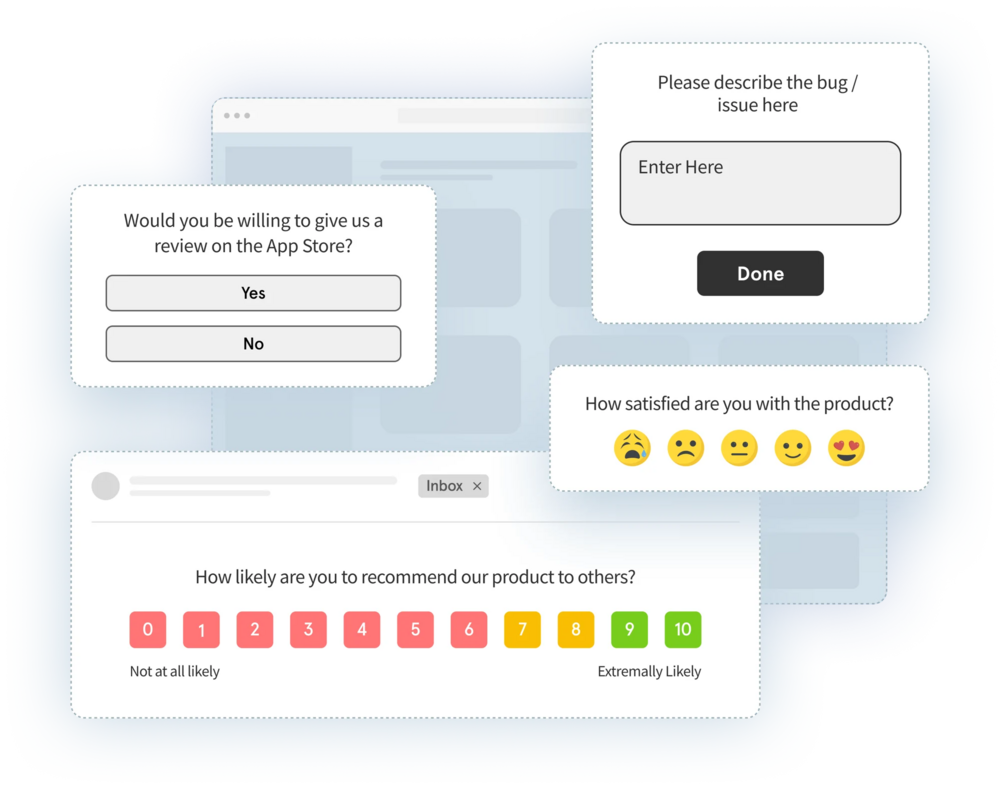





.jpg)
.jpg)
.jpg)

.jpg)
.jpg)

